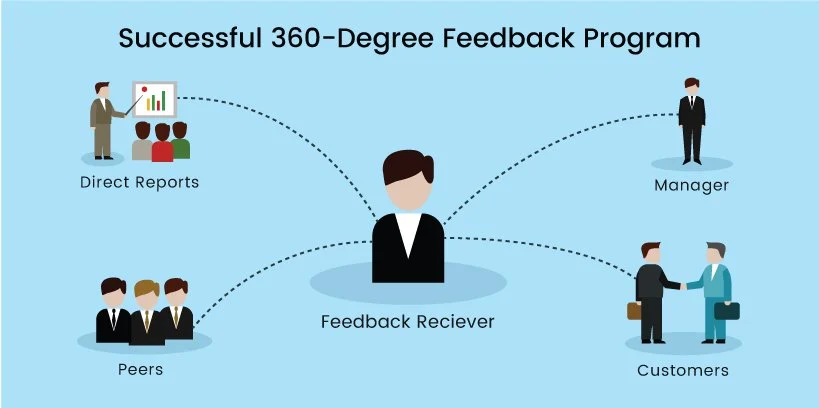Introduction:
Unlocking Potential with 360-Degree Feedback Mechanism
In the dynamic world of career advancement, the ‘360-Degree Feedback Mechanism’ stands out as a revolutionary tool, reshaping how professionals understand and enhance their performance. This comprehensive blog post delves into the intricacies of the 360-Degree Feedback Mechanism, a pivotal strategy for those aspiring for rapid career growth. By offering a multifaceted view of an individual’s skills, behaviors, and work impact, this mechanism provides invaluable insights that traditional feedback methods often miss. Whether you’re a seasoned professional or just starting out, understanding and leveraging the 360-Degree Feedback Mechanism can be a game-changer in your career trajectory.
Navigating Career Growth with 360-Degree Feedback
Welcome to our in-depth exploration of the ‘360-Degree Feedback Mechanism’, one of the essential tools for anyone seeking to accelerate their career growth. In today’s fast-paced professional environment, receiving feedback from a variety of sources – peers, supervisors, subordinates, and even clients – can provide a well-rounded perspective on your performance. This blog post aims to guide you through the concept of 360-Degree Feedback, demonstrating how it can be effectively utilized to identify strengths, uncover areas for improvement, and set actionable goals. Join us as we unravel the benefits and best practices of this transformative approach to professional development.
Empowering Your Career with 360-Degree Insights
The journey to rapid career progression is often challenging, yet immensely rewarding. A crucial part of this journey is the implementation of the ‘360-Degree Feedback Mechanism’. This innovative feedback tool goes beyond traditional performance reviews, offering a holistic view of an individual’s abilities and impact in the workplace. In this blog post, we will explore how the 360-Degree Feedback Mechanism can empower professionals to achieve their career goals by providing a diverse range of perspectives on their performance. Learn how to harness this tool effectively to create a roadmap for your professional growth and success.
Table of Contents
What is 360-Degree Feedback Mechanism?

The ‘360-Degree Feedback Mechanism’ is a comprehensive appraisal method that offers a complete view of an employee’s performance by gathering feedback from a circle of reviewers. This includes not only their supervisors but also peers, subordinates, and sometimes, external stakeholders like clients or suppliers. Unlike traditional feedback systems that rely solely on a supervisor’s perspective, the 360-Degree Feedback Mechanism provides a multi-dimensional view, capturing a wide range of competencies such as communication, teamwork, leadership, and problem-solving skills.
This holistic approach ensures a balanced evaluation, fostering an environment of transparency and mutual respect in the workplace. It encourages employees to reflect on their strengths and areas for improvement from diverse viewpoints, ultimately leading to enhanced personal and professional development. By integrating the 360-Degree Feedback Mechanism, organizations can cultivate a more engaged, self-aware, and high-performing workforce, aligning individual growth with organizational goals.
Why a ’ 360-Degree Feedback Mechanism’ is needed for rapid career growth?
Comprehensive Performance Insights
The ‘360-Degree Feedback Mechanism’ is crucial for rapid career growth as it provides a well-rounded analysis of an employee’s performance. By gathering feedback from various sources – managers, peers, subordinates, and sometimes external clients – it offers a multi-faceted view of an individual’s strengths and areas needing improvement. This comprehensive understanding is vital for personal development and career advancement, allowing individuals to pinpoint specific skills to hone for future success.
Enhanced Self-Awareness
Utilizing a 360-Degree Feedback Mechanism fosters greater self-awareness among employees. It uncovers blind spots in one’s professional behavior and skills, which might be overlooked in traditional feedback methods. This increased self-awareness is a stepping stone to personal growth, enabling professionals to make informed decisions about their career paths and work on aspects crucial for their advancement.
Balanced Feedback for Objective Assessment
The diverse perspectives provided by the 360-Degree Feedback Mechanism ensure a more balanced and objective assessment of an employee’s capabilities. This balanced feedback helps in eliminating biases that might occur when feedback comes solely from a direct supervisor. Objective assessments are fundamental for identifying true talent and potential, thereby facilitating equitable opportunities for career progression.
Cultivating Leadership Skills
For those aspiring to leadership roles, the 360-Degree Feedback Mechanism is invaluable. It not only assesses technical skills but also evaluates soft skills like leadership, teamwork, and communication – essential qualities for effective leadership. This feedback helps aspiring leaders understand how their actions and leadership style are perceived by others, guiding them in refining their approach to be more effective leaders.
Promoting a Culture of Continuous Improvement
Implementing a 360-Degree Feedback Mechanism cultivates a culture of continuous learning and improvement within an organization. When employees receive regular, constructive feedback from multiple sources, it motivates them to continually develop their skills and adapt to changing workplace demands. This culture of ongoing personal and professional development is key to rapid career growth, as it encourages individuals to consistently strive for excellence in their roles.
How to design and build a ’ 360-Degree Feedback Mechanism’ solution?
Identify Clear Objectives
The first step in designing an effective ‘360-Degree Feedback Mechanism’ is to establish clear objectives. Determine what you want to achieve with the feedback process – whether it’s enhancing employee development, improving communication skills, or identifying potential leaders. Setting specific goals ensures that the feedback mechanism is aligned with your organizational needs and delivers tangible benefits.
Select the Right Participants
Careful selection of feedback providers is crucial in a 360-Degree Feedback Mechanism. Choose a diverse group of respondents, including supervisors, peers, subordinates, and, if relevant, external clients. Ensure that these participants have sufficient interaction with the employee to provide meaningful and accurate feedback. A well-chosen mix of reviewers helps in garnering a comprehensive view of the employee’s performance and behavior.
Develop Comprehensive Questionnaires
Crafting well-structured and relevant questionnaires is a core component of the 360-Degree Feedback Mechanism. Questions should cover a range of competencies and behaviors relevant to the employee’s role and the organization’s culture. Use a mix of rating scales and open-ended questions to elicit both quantitative and qualitative feedback. Clarity and neutrality in questions are essential to avoid any bias in responses.
Ensure Anonymity and Confidentiality
For honest and uninhibited feedback, maintaining the anonymity of respondents is vital in a 360-Degree Feedback Mechanism. Assure participants that their responses will be kept confidential and used solely for development purposes. This encourages more candid and useful feedback, as reviewers are less likely to be influenced by interpersonal dynamics.
Utilize a Robust Feedback Software
Implementing a user-friendly and secure software solution can significantly enhance the effectiveness of the 360-Degree Feedback Mechanism. A good platform allows for easy distribution and collection of feedback, ensures data privacy, and can analyze and present feedback in an actionable format. Choosing the right technology is key to a smooth and efficient feedback process.
Provide Training and Support
Before rolling out the 360-Degree Feedback Mechanism, provide training to both the feedback givers and receivers. Educate them about the purpose of the feedback, how to give and receive feedback constructively, and the way the process works. This preparation helps in reducing anxieties and misconceptions, leading to a more successful implementation.
Act on Feedback and Follow Up
Designing the 360-Degree Feedback Mechanism is only the first step; acting on the feedback is crucial. Encourage employees to create development plans based on the feedback and provide resources and support for their growth. Additionally, regular follow-up and re-assessment ensure that the feedback mechanism leads to continuous improvement and is not just a one-time exercise. This reinforces the culture of ongoing development and shows the organization’s commitment to its employees’ growth.
Conclusion
In conclusion, the ‘360-Degree Feedback Mechanism’ stands as a transformative tool in the landscape of employee development and organizational growth. By providing a holistic and multi-perspective view of an individual’s performance, it paves the way for meaningful personal and professional development. Its implementation, when done thoughtfully and effectively, can lead to enhanced self-awareness, improved communication, and a stronger alignment of individual goals with organizational objectives.
As we have explored in this blog post, the key to unlocking the full potential of the 360-Degree Feedback Mechanism lies in its careful design, inclusive participation, and a commitment to ongoing improvement. Embracing this comprehensive feedback approach can significantly contribute to the cultivation of a dynamic, responsive, and high-performing workforce, essential for any organization aiming to thrive in today’s competitive environment.
Please answer this question in comment section below: Which of the above 360-Degree Feedback Mechanism features might work best in your opinion?
References and further study:
- The Evolution and Devolution of 360° Feedback – Cambridge Core: This article provides a historical perspective on the evolution of the 360-Degree Feedback concept. It traces the development from its early days in the 1980s-1990s, discusses various approaches, and offers a definition for the modern practice of 360-Degree Feedback
- What Makes a 360-Degree Review Successful? – Harvard Business Review: This article from Harvard Business Review explores the key elements that make a 360-Degree review process effective. It focuses on how this feedback mechanism can bring about meaningful change and improvement in employee performance
- An Exploratory Study of the Process and Problems of 360-Degree Feedback – Sage Journals: This study examines the implementation of 360-Degree Feedback mechanisms in IT organizations. It aims to provide insights into the process and potential challenges faced when applying this method in a corporate setting.


Hi, I want to subscribe for this weblog to obtain latest updates,
thus where can i do iit please help. https://www.waste-Ndc.pro/community/profile/tressa79906983/